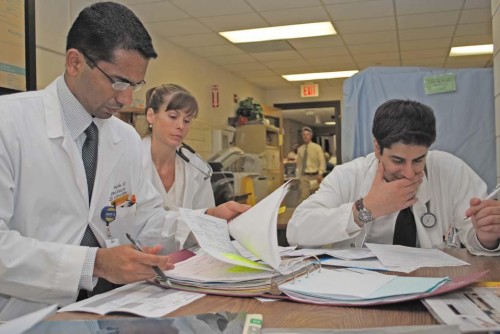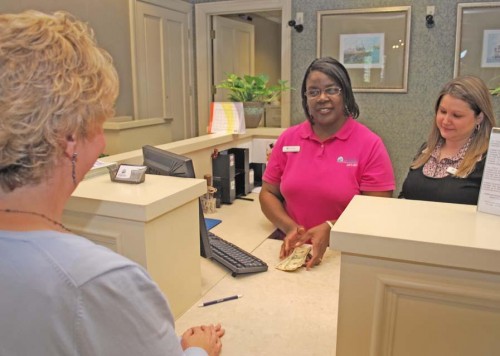
First-year docs learning on the front line at Chabert
April 22, 2009Beulah Bergeron
April 24, 2009Ignore the bad news coming from outside Louisiana. Banks in the Tri-parishes are well-capitalized and have money to lend to qualified customers.
That is the message area bank executives are sending out, responding to the much-publicized failures of several large banks nationally in recent months.
However, the public is not distinguishing between relatively lightly-regulated investment firms, whose focus is stocks and bonds, and commercial banks that are insured by the Federal Deposit Insurance Corporation, bank executives said.
“The media hasn’t done community banking any favors,” said Steve Crispino, vice president of South Louisiana Bank, the largest bank headquartered in the Tri-parishes with $350.7 million in assets in 2008. “The media uses the term ‘bank’ loosely. They’re not giving community banks credit for being strong.”
“We had a strong 2008, and so is 2009,” he said. “Banking is not bad in general. We have issues with larger banks. Community banking is not any better in the country than in Louisiana. We’re not allowed to do some of the things (investment) banks are allowed to do. They make investments, we make loans.”
“The national media is doing a horrible job of making distinctions,” said Mark Folse, president and CEO of Coastal Commerce Bank, the third largest bank based in the Tri-parishes with $325.7 million in assets in 2008. “They’re talking about insurance companies and brokerage houses.”
“People presume the banking industry is in dire straits,” he said. “They’re amazed to see we’re doing as well as we are. The perception is there is suffering across the country, but it’s not the case here.”
FDIC data from last year shows banks in Louisiana handily outpacing the rest of the nation in asset growth (10 percent to 6 percent) and deposit growth (8.3 percent to 7.4 percent).
But the biggest difference came in loan growth. Banks in the rest of the country showed a decline in 2008 of .4 percent. Loan growth for banks in Louisiana was 11.4 percent.
“The national news – CNBC, CNN – what they’re saying is what the government is saying,” said Robert Taylor, CEO of the Baton Rouge-based Louisiana Bankers Association. “The Treasury is lumping everyone together.”
“They talk about banks not making loans,” he said. “We don’t have that here with us. People don’t understand that there’s a difference. Back here, we have people asking if we’re in trouble. That doesn’t have anything to do with here.”
Taylor said banks in the Tri-parishes are healthy.
“I was down there not long ago,” he said. “I talked to most of the bankers. They had a good story to tell.”
Taylor felt that bankers in the Tri-parishes learned hard lessons from the recession that hit the area beginning in the 1980s.
“It was really bad in Houma,” he said. “Property values declined around 50 percent. Savings and loans failed.”
Some bank executives who were active then are still around.
“They know good times don’t last forever,” Taylor said. “They focus on basic underwriting.”
“Lending practices were sloppy then” during the ’80s recession, Folse said. “Most business runs in cycles.”
“Last time around was more of a gold rush mentality,” he said. “They thought the good times would never end.”
Investments were made in oilfields and marine industries for tax purposes.
“They got in wrong, they couldn’t see what was going on,” he said. “Today, most businesses have a better idea of what they’re doing.”
Nationally, with the recent banking crisis, people who should not have qualified received loans. Lending was relaxed.
But although banks in Louisiana engaged in some excessive “hand-holding” with customers following hurricanes Katrina and Rita, Taylor said, “the way they run banks now is profit, conservative, the basics.”
Local banks tended to stay away from speculative deals and subprime loans.
“We’re engaged in more traditional banking,” Folse said.
Bank executives stressed that they have been strictly evaluating potential customers.
“There’s a perception banks are not lending – that’s wrong – but we are looking more closely at ability to pay,” said Robert Naquin, Capital One Bank’s market president for Terrebonne, Lafourche and Assumption parishes. “We’ve always been pretty stringent about underwriting criteria.”
Crispino said, “South Louisiana Bank has always looked at credit-worthiness. It shows in our profitability. We’ve never strayed from our core principles of lending.”
“We haven’t changed, we’re cognizant,” Folse said. “We’re still making loans to those who are credit-worthy. That story has not been told well.”
Another reason local banks have stayed healthy is that they have constrained their out-of-market lending. Some commercial banks in the rest of the country failed because they pursued loan opportunities elsewhere.
Taylor gave as an example banks in Georgia financing condominium construction in Florida, chasing appreciated values of property.
“Banks here stick to their own market,” Taylor said. “Banks in Houma stick to their own area.”
“It sounds logical, but when you get into that fever – go, go, go – you have to resist it,” he said. “That’s why you see the problems in the country. A lot of people piled into that.”
“Local banks have stayed within our footprint,” Naquin said. “We have had exceptional borrowing. We have not solicited outside our footprint.”
Crispino said South Louisiana Bank keeps out-of-market loans at around 3 percent of the bank’s portfolio to preserve diversification.
“No bank I know has done crazy stuff like in other parts of the country,” he said.
To boost failing financial institutions, the federal government created the Troubled Assets Relief Program last year and the Capital Purchase Program to increase the lending capacity of healthy banks.
Virginia-based Capital One received $3.56 billion.
Capital One began as a credit card company, then expanded by acquiring Hibernia National Bank in 2005 and other regional institutions.
“Our people have been here a long time. We’re not new to banking,” Naquin said.
Capital One did not need the infusion of capital from the federal government, he said.
“We were asked by the Treasury to take funds for the good of the system,” Naquin said. “Because of that we got involved. Money was to be reinfused into the system.”
Taylor said federal regulators encouraged banks in the state to take CPP funds, but the public still does not distinguish between that program and the bailout money AIG and Chrysler have received.
“If you’re a banker in Baton Rouge or Houma, you ask, ‘Why does the government want to invest in my bank?'” he said. “Banks had to be healthy to participate. It’s strengthening strong banks to make them healthier.”
Neither South Louisiana Bank nor Coastal Commerce Bank received federal money, but they don’t begrudge those institutions that did.
“Banks that took TARP money are not bad, but we didn’t need it,” Crispino said.
In February, Lafayette-based Iberiabank announced it was returning the $90 million the bank received from the federal government, becoming the first bank in the country to do so.
MidSouth, another Lafayette-based bank, may return the $20 million it received from the federal government, President Rusty Cloutier announced at a meeting held in February at the Houma branch.
Of more concern to Folse is the condition of the Federal Deposit Insurance Corporation, which is funded entirely with premiums paid by member banks. Deposits are currently insured up to $250,000 through the end of 2009.
The FDIC has had its funds depleted, Folse said, forcing member banks to pay higher premiums.
Taylor said the vast majority of troubled loans have come from financial agencies that are not part of the FDIC. An exception was California-based IndyMac Bank, the failure of which hammered the FDIC for $11 billion.
“It affects us because our guys have to pay premiums to make up the loss,” Taylor said. “Our collective intent is to make sure regulators do their jobs. Banks want regulators to do a thorough, fair job.”
Taylor also feels the Community Reinvestment Act, which encourages commercial banks to lend to lower- and moderate-income households, has nothing to do with the country’s current banking crisis.
“In my opinion, it’s a cop-out to blame the CRA,” he said.
But no one is casting the local banking industry in a bad light.
“Community banks know how to lend, you have to know what you’re doing,” Taylor said, especially in a state as relatively poor as Louisiana. “We work closely with people. It’s more personal banking.”
“We’ve been in this for several months now and banks in the local area are holding up well,” Folse said. “It’s a good sign. We’re making out better than most.”
Coastal Commerce Bank teller Jacquelyn Ross (middle) handles a transaction with a customer as customer service representative Cayla Cayette (right) looks on. Tri-parish banks, including Coastal Commerce, report that local banks have not been impacted to the extent larger national institutions have by the economic decline. * Photo by KEYON K. JEFF














